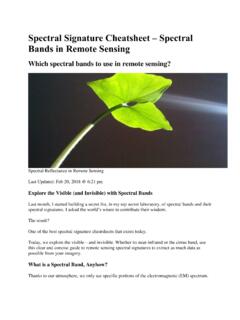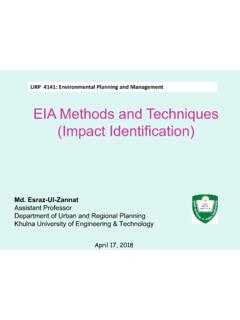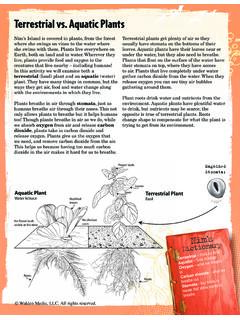Transcription of Resolutions of Remote Sensing - Environmental Data Center
1 1 Resolutions of Remote Sensing1. Spatial(what area and how detailed)2. Spectral (what colors bands)3. Temporal (time of day/season/year)4. Radiometric (color depth)Spatial Resolution describes how much detail in a photographic image is visible to the human eye. The ability to "resolve," or separate, small details is one way of describing what we call spatial resolution of images acquired by satellite sensor systems is usually expressed in meters. For example, we often speak of Landsat as having 30-meter" resolution, which means that two objects, thirty meters long or wide, sitting side by side, can be separated (resolved) on a Landsat sensors have lower or higher spatial of Landsat Sensors Thematic Mapper (TM) Landsat 4 and 5 Enhanced Thematic Mapper Plus (ETM+) Landsat 7 Multispectral Scanner (MSS) Landsat 1-5 Spectral Resolution ( m) 1.
2 (B) 2. (G) 3. (R) 4. (NIR) 5. (MIR) 6. (MIR) 7. (TIR) 1. 2. 3. 4. 5. 6. 7. 8. (Pan) (green) (red) (NIR) (NIR) Spatial Resolution (meter) 30 x 30 120 x 120 (TIR) 15 x 15 (Pan) 30 x 30 60 x 60 (TIR) 79 x 79 Temporal Resolution (revisit in days) 16 16 18 Spatial coverage (km) 185 x 185 183 x 170 185 x 185 Altitude (km) 705 705 915 (Landsat 1,2,3) 3 Planimetric data roads, buildings.
3 DrivewaysSpatial Resolution80 meter MSS w/ planimetric overlaySpatial Resolution430 meter TM w/ planimetric overlaySpatial Resolution10 meter SPOT w/ planimetric overlaySpatial Resolution51 meter DOQ w/ planimetric overlaySpatial ResolutionSub-meter data w/ planimetric overlaySpatial Resolution6 Looking More Closely at ResolutionLooking More Closely at Resolution7 Landsat MSS Satellite80 Meter Resolution Grid CellLooking More Closely at ResolutionLandsat TM Satellite30 Meter Resolution Grid CellLooking More Closely at Resolution8 SPOT Satellite 10 Meter Resolution Grid CellLooking More Closely at ResolutionIKONOS Satellite 4 Meter Resolution Grid CellLooking More Closely at Resolution9 IKONOS Satellite 1 Meter Resolution Grid CellLooking More Closely at ResolutionLandsat 7185 by 170 km30-m multispectralIndian Remote Sensing145 by 145 km25-m multispectralSPOT60 by 60 km20-m multispectralQuickBird 216 by 16 multispectralIKONOS11 by 11 km 4-m multispectralSelected Satellite FootprintsOrbView 38 by 8 km 4-m multispectral1-m panchromatic10101001010010 Resolutions of Remote Sensing1.
4 Spatial(what area and how detailed)2. Spectral (what colors bands)3. Temporal (time of day/season/year)4. Radiometric (color depth)The best spatial resolution?111. Spatial (what area and how detailed)2. Spectral (what colors bands)3. Temporal (time of day/season/year)4. Radiometric (color depth) Resolutions of Remote SensingSpectral Response patterns are recorded by sensors with separated spectral Radiation (EMR)Spectral Response Curve13 The spectral reflectance curves, or spectral signatures, of different types of ground targets provide the knowledge base for information Response Curve14 Spectral Response CurveSpectral responses from ground tragetsare recorded in separate spectral bands by of Spectral BandsSpectral Resolution Number of spectral bands (red, green, blue, NIR, Mid-IR, thermal, etc.)
5 Width of each band Certain spectral bands (or combinations) are good for identifying specific ground features Panchromatic 1 band (B&W) Color 3 bands (RGB) Multispectral 4+ bands ( RGBNIR) Hyperspectral hundreds of bands15 Comparison of Landsat Sensors Thematic Mapper (TM) Landsat 4 and 5 Enhanced Thematic Mapper Plus (ETM+) Landsat 7 Multispectral Scanner (MSS) Landsat 1-5 Spectral Resolution ( m) 1. (B) 2. (G) 3. (R) 4. (NIR) 5. (MIR) 6. (MIR) 7. (TIR) 1. 2. 3. 4. 5. 6. 7. 8. (Pan) (green) (red) (NIR) (NIR) Spatial Resolution (meter) 30 x 30 120 x 120 (TIR) 15 x 15 (Pan) 30 x 30 60 x 60 (TIR) 79 x 79 Temporal Resolution (revisit in days) 16 16 18 Spatial coverage (km) 185 x 185 183 x 170 185 x 185 Altitude (km) 705 705 915 (Landsat 1,2,3)
6 QuickBird Satellite True-color and Pseudo-color Spatial ResolutionConcept of MultispectralAnd Pseudo-color Image16 Landsat-7 ETM+ Data (30 m), Bands 4, 3, 2 inRGBL andsat-7 Panchromatic Data (15 m)Landsat-7 ETM+ Data (30 m), Bands 3, 2, 1 inRGBL andsat-7 ETM+ Data (30 m), Bands 4, 5, 3 inRGBS pectral Response CurveApril and May Spectra for P. australis and S. patens (nm)Reflectance (%)April P. australisMay P. australisApril S. patensMay S. patensBlueGreenRedNIR17 Spectral Response CurvesApril and May Spectra for P. australis and S. patens (nm)Reflectance (%)April P. australisMay P. australisApril S. patensMay S.
7 PatensBlueGreenRedNIRMid-IRVioletAirborn e Terrestrial Applications Sensor (ATLAS)18 Landsat-7 ETM+1 - 4576band #ATLAS1 - 67810 1112131415band #wavelength ( m) 1: m (blue).Provide increased penetration of water bodies, as well as supporting analysis of land use, soil, and vegetation 2: m (green).This band spans the region between the blue and red chlorophyll absorption bands and therefore corresponds to the green reflectance of healthy 3: m (red).This is the red chlorophyll absorption band of healthy green vegetation and represents one of the most important bands for vegetation Cover ofLandsat Sensors19 Band 4: m (reflective infrared).
8 This band is responsive to the amount of vegetation biomass present in the scene. It is useful for crop identification and emphasizes soil-crop and land-water contrasts. Band 5: m (mid-infrared)This band is sensitive to the amount of moisture in plants and therefore useful in crop draught and in plant vigor studies. Band 6: m (thermal infrared)This band measures the amount of infrared radiant flux emitted from surface. Band 7: m (mid-infrared)This is an important band for the discrimination of geologic rock formation. It is effective in identifying zones of hydrothermal alteration in Cover ofLandsat SensorsHyperspectral DataExample:Hyperion hyperspectral sensor is capable of resolving 220 spectral bands at 10 nm interval (from to m) with a 30 meter spatial resolution.
9 The shown image, acquired April 6, 2004, is displayed m in m in m in Bluecolor20 Hyperspectral DataAVIRIS DataNinigret PondRhode IslandTrue ColorThermal Band (Landsat TM band 6)211. Spatial (what area and how detailed)2. Spectral (what colors bands)3. Temporal(time of day/season/year)4. Radiometric (color depth) Resolutions of Remote SensingTemporal ConsiderationsTime of day/season image acquisition Leaf on/leaf off Tidal stage Seasonal differences Shadows Phenological differences Relationship to field sampling22 Spring - bands 4,5,3 Spatial Spectral Temporal(seasonal) RadiometricSeasonal ConsiderationsSummer - bands 4,5,3 Spatial Spectral Temporal(seasonal) RadiometricSeasonal Considerations23 Seasonal Leaf-on vs.
10 Leaf-offSeasonal Leaf-on vs. (5,895m)Mt. Meru(4,566m)Forest Cover1987Mt. Meru(4,566m) (5,895m)Forest Cover200025 Landsat June 21, 2000 Landsat June 14, 200326 How much has changed?How severe was the damage?What will be the ecosystem impacts?..Repeat Coverage Considerations Revisit period for satellites how often can you make a measurement for the same area Landsat 16 days (continuous collection) Quickbird varies (point-and-shoot) MODIS daily (continuous collection) Airborne images collected as needed27 Comparison of Landsat Sensors Thematic Mapper (TM) Landsat 4 and 5 Enhanced Thematic Mapper Plus (ETM+) Landsat 7 Multispectral Scanner (MSS) Landsat 1-5 Spectral Resolution ( m) 1.







